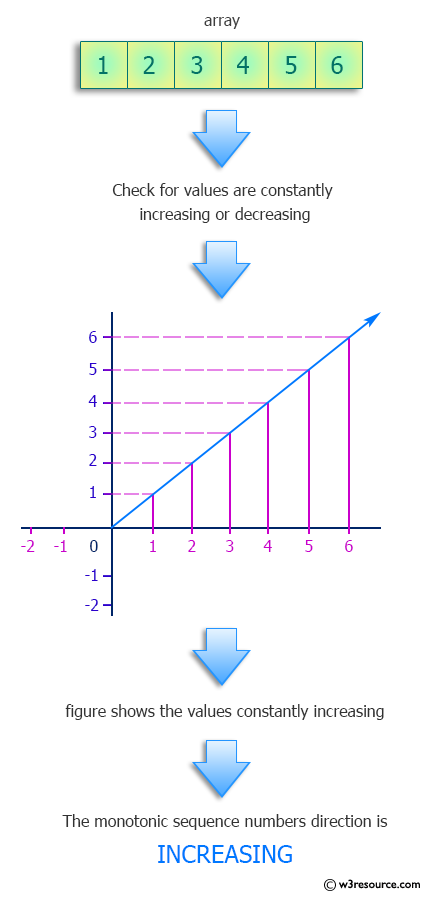Python: Determine the direction ('increasing' or 'decreasing') of monotonic sequence numbers
Determine Monotonic Direction
Monotonic sequences are sequences, which constantly increase or constantly decrease.
Write a Python program to determine the direction ('increasing' or 'decreasing') of monotonic sequence numbers.
Input: [1, 2, 3, 4, 5, 6] Output: Increasing. Input: [6, 5, 4, 3, 2, 1] Output: Decreasing. Input: [19, 19, 5, 5, 5, 5, 5] Output: Not a monotonic sequence!
Visual Presentation:



Sample Solution:
Python Code:
# License: https://bit.ly/3oLErEI
# Define a function named 'test' that takes a list of numbers 'nums' as input
def test(nums):
# Check if all elements in the list 'nums' are in increasing order
if all(nums[i] < nums[i + 1] for i in range(len(nums) - 1)):
return "Increasing."
# Check if all elements in the list 'nums' are in decreasing order
elif all(nums[i + 1] < nums[i] for i in range(len(nums) - 1)):
return "Decreasing."
else:
return "Not a monotonic sequence!"
# Assign a specific list of numbers 'nums' to the variable
nums = [1, 2, 3, 4, 5, 6]
# Print the original list of numbers 'nums'
print("Original list:")
print(nums)
# Print a message indicating the operation to be performed
print("Check the direction ('increasing' or 'decreasing') of the said list:")
# Print the result of the test function applied to the 'nums' list
print(test(nums))
# Assign a different list of numbers 'nums' to the variable
nums = [6, 5, 4, 3, 2, 1]
# Print the original list of numbers 'nums'
print("\nOriginal list:")
print(nums)
# Print a message indicating the operation to be performed
print("Check the direction ('increasing' or 'decreasing') of the said list:")
# Print the result of the test function applied to the updated 'nums' list
print(test(nums))
# Assign another different list of numbers 'nums' to the variable
nums = [19, 19, 5, 5, 5, 5, 5]
# Print the original list of numbers 'nums'
print("\nOriginal list:")
print(nums)
# Print a message indicating the operation to be performed
print("Check the direction ('increasing' or 'decreasing') of the said list:")
# Print the result of the test function applied to the updated 'nums' list
print(test(nums))
Sample Output:
Original list:
[1, 2, 3, 4, 5, 6]
Check the direction ('increasing' or 'decreasing') of the said list:
Increasing.
Original list:
[6, 5, 4, 3, 2, 1]
Check the direction ('increasing' or 'decreasing') of the said list:
Decreasing.
Original list:
[19, 19, 5, 5, 5, 5, 5]
Check the direction ('increasing' or 'decreasing') of the said list:
Not a monotonic sequence!
Flowchart:

For more Practice: Solve these Related Problems:
- Write a Python program to determine if a sequence of numbers is strictly increasing, strictly decreasing, or neither.
- Write a Python program to compare each element with the previous one and output 'Increasing', 'Decreasing', or 'Not a monotonic sequence'.
- Write a Python program to implement a function that checks monotonicity by using pairwise comparisons.
- Write a Python program to verify the direction of a sequence using the all() function with a generator expression.
Go to:
Previous: Split a string into strings if there is a space in the string, otherwise split on commas, otherwise the list of lowercase letters with odd order.
Next: Determine, for each string in a list, whether the last character is an isolated letter.
Python Code Editor :
Have another way to solve this solution? Contribute your code (and comments) through Disqus.
What is the difficulty level of this exercise?
Test your Programming skills with w3resource's quiz.
